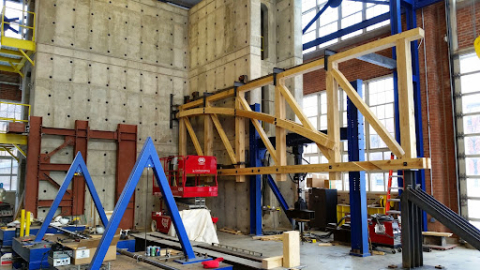The Richard '39 and Opal Vanderhoof Infrastructure Research and Education Facility and the William H. Schuette '33 Structural Laboratory are premier facilities for large-scale structural testing. They are used for both education and research on the performance of large-scale infrastructure components. It is available for use by academic researchers, industry, and governmental agencies.
The facility is designed for both static and dynamic testing and is capable of experimental testing techniques to determine stiffness, strength, fatigue strength, fracture toughness, dynamic properties, and cyclic hysteretic behavior of structures, among others.
The facility features a 1,500 square foot strong floor and 28 foot high, L-shaped strong wall with tie-down points on a 2 foot grid with a capacity of 60,000 pounds each. The wall also provides a 500 ton reaction test cell. Four six-foot by six-foot uni-directional shaking tables provide capabilities for application of dynamic horizontal support motions. The tables are designed to be stacked and rotated such that bi-direction motion can also be simulated. Laboratory hydraulic fluid is supplied at 3000 psi to actuators through a stainless steel pipe network to five power stations. A 95-gallon-per-minute hydraulic power supply is situated in a separate, sound-containing room. The pump and oil temperature are controlled by a separate water cooling loop and rooftop heat exchanger. The hydraulic system is controlled by a four-channel MTS FlexTest 60 digital controller. Laboratory activities are supported by a 15-ton crane and 32 foot scissor lift. Two 55-kip and four 22-kip hydraulic actuators are available for structural testing. Controlled force, displacement, or strain may be applied at frequencies up to 20Hz.
Additional laboratory and machining space to support specimen fabrication and preparation is situated adjacent to this laboratory including the Bingham Concrete Laboratory. Machining and fabrication equipment includes welding machines, drill presses, grinders, saws, among many others. Various other MTS servo-hydraulic material testing equipment is available that can apply axial compression (220 kip) and axial tension/compression (50 kip) loads to specimens. The 50-kip machine also includes hydraulically controlled grips to attach specimens.
The facility supports one of the principal objectives of the Civil and Environmental Engineering Department at Case: to provide advanced education and perform advanced research focused on our built infrastructure.
The laboratory also has critical equipment for the testing of small-scale models made of different materials (steel, concrete, wood, plastic) to study the response of prototype structural elements and/or assemblies. The equipment includes four 42-inch by 72-inch steel testing tables, aluminum reaction frames with mechanical screw presses, and a series of portable strain indicators with companion switch and balance units.

